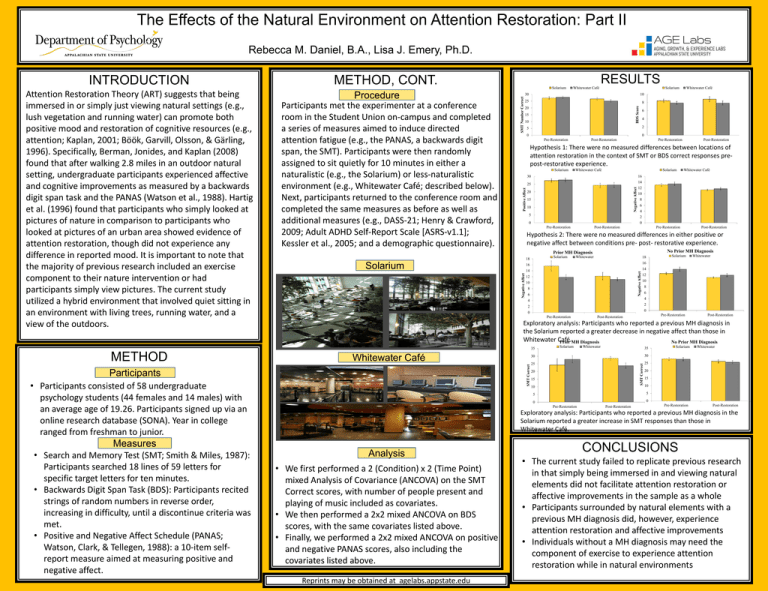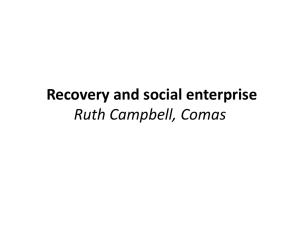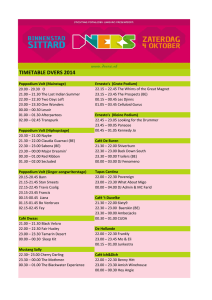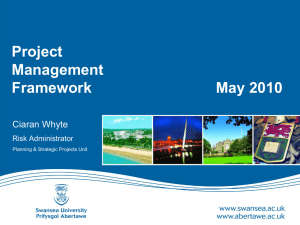Part II
advertisement

The Effects of the Natural Environment on Attention Restoration: Part II Rebecca M. Daniel, B.A., Lisa J. Emery, Ph.D. 10 25 8 20 15 10 4 2 0 0 Pre-Restoration Post-Restoration Pre-Restoration Post-Restoration Hypothesis 1: There were no measured differences between locations of attention restoration in the context of SMT or BDS correct responses prepost-restorative experience. Solarium Whitewater Café Solarium 30 Whitewater Café 16 14 Negative Affect 25 20 15 10 5 12 10 8 6 4 2 0 0 Pre-Restoration Post-Restoration Pre-Restoration Post-Restoration Hypothesis 2: There were no measured differences in either positive or negative affect between conditions pre- post- restorative experience. No Prior MH Diagnosis Prior MH Diagnosis Solarium 18 Whitewater Solarium 18 16 16 14 14 Negative Affect Solarium 12 10 8 6 Whitewater 12 10 8 6 4 4 Whitewater Café Whitewater Café 6 5 2 2 0 0 Pre-Restoration Pre-Restoration Post-Restoration Post-Restoration Exploratory analysis: Participants who reported a previous MH diagnosis in the Solarium reported a greater decrease in negative affect than those in Whitewater Café. Prior MH Diagnosis No Prior MH Diagnosis Solarium Whitewater 35 30 30 25 25 SMT Correct Whitewater Café SMT Correct Participants • Participants consisted of 58 undergraduate psychology students (44 females and 14 males) with an average age of 19.26. Participants signed up via an online research database (SONA). Year in college ranged from freshman to junior. Measures • Search and Memory Test (SMT; Smith & Miles, 1987): Participants searched 18 lines of 59 letters for specific target letters for ten minutes. • Backwards Digit Span Task (BDS): Participants recited strings of random numbers in reverse order, increasing in difficulty, until a discontinue criteria was met. • Positive and Negative Affect Schedule (PANAS; Watson, Clark, & Tellegen, 1988): a 10-item selfreport measure aimed at measuring positive and negative affect. Solarium 30 35 METHOD Whitewater Café BDS Score SMT Number Correct Procedure Participants met the experimenter at a conference room in the Student Union on-campus and completed a series of measures aimed to induce directed attention fatigue (e.g., the PANAS, a backwards digit span, the SMT). Participants were then randomly assigned to sit quietly for 10 minutes in either a naturalistic (e.g., the Solarium) or less-naturalistic environment (e.g., Whitewater Café; described below). Next, participants returned to the conference room and completed the same measures as before as well as additional measures (e.g., DASS-21; Henry & Crawford, 2009; Adult ADHD Self-Report Scale [ASRS-v1.1]; Kessler et al., 2005; and a demographic questionnaire). Solarium Positive Affect Attention Restoration Theory (ART) suggests that being immersed in or simply just viewing natural settings (e.g., lush vegetation and running water) can promote both positive mood and restoration of cognitive resources (e.g., attention; Kaplan, 2001; Böök, Garvill, Olsson, & Gärling, 1996). Specifically, Berman, Jonides, and Kaplan (2008) found that after walking 2.8 miles in an outdoor natural setting, undergraduate participants experienced affective and cognitive improvements as measured by a backwards digit span task and the PANAS (Watson et al., 1988). Hartig et al. (1996) found that participants who simply looked at pictures of nature in comparison to participants who looked at pictures of an urban area showed evidence of attention restoration, though did not experience any difference in reported mood. It is important to note that the majority of previous research included an exercise component to their nature intervention or had participants simply view pictures. The current study utilized a hybrid environment that involved quiet sitting in an environment with living trees, running water, and a view of the outdoors. RESULTS METHOD, CONT. Negative Affect INTRODUCTION 20 15 10 15 10 5 0 0 Post-Restoration Whitewater 20 5 Pre-Restoration Solarium Pre-Restoration Post-Restoration Exploratory analysis: Participants who reported a previous MH diagnosis in the Solarium reported a greater increase in SMT responses than those in Whitewater Café. Analysis • We first performed a 2 (Condition) x 2 (Time Point) mixed Analysis of Covariance (ANCOVA) on the SMT Correct scores, with number of people present and playing of music included as covariates. • We then performed a 2x2 mixed ANCOVA on BDS scores, with the same covariates listed above. • Finally, we performed a 2x2 mixed ANCOVA on positive and negative PANAS scores, also including the covariates listed above. Reprints may be obtained at agelabs.appstate.edu CONCLUSIONS • The current study failed to replicate previous research in that simply being immersed in and viewing natural elements did not facilitate attention restoration or affective improvements in the sample as a whole • Participants surrounded by natural elements with a previous MH diagnosis did, however, experience attention restoration and affective improvements • Individuals without a MH diagnosis may need the component of exercise to experience attention restoration while in natural environments







